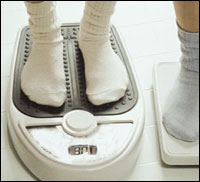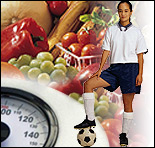Defining Childhood Overweight and Obesity
 Body
mass index (BMI) is a practical measure used to determine overweight and
obesity. BMI is
a measure of weight in relation to height that is used to determine weight
status. BMI can be calculated using either English or metric units. BMI is the most widely accepted method used to screen for overweight
and obesity in
children and adolescents because it is relatively easy to obtain the height
and weight measurements needed to calculate BMI, measurements are
non-invasive and BMI correlates with body fatness.6 While BMI is
an accepted screening tool for the initial assessment of body fatness in
children and adolescents, it is not a diagnostic measure because BMI is not
a direct measure of body fatness.
Body
mass index (BMI) is a practical measure used to determine overweight and
obesity. BMI is
a measure of weight in relation to height that is used to determine weight
status. BMI can be calculated using either English or metric units. BMI is the most widely accepted method used to screen for overweight
and obesity in
children and adolescents because it is relatively easy to obtain the height
and weight measurements needed to calculate BMI, measurements are
non-invasive and BMI correlates with body fatness.6 While BMI is
an accepted screening tool for the initial assessment of body fatness in
children and adolescents, it is not a diagnostic measure because BMI is not
a direct measure of body fatness.
Use of BMI to Screen for Overweight and Obesity in Children
 |
|
|
Child and Teen BMI Calculator |
|
For children and adolescents (aged 2–19 years), the BMI value is plotted on the CDC growth charts to determine the corresponding BMI-for-age percentile. Overweight is defined as a BMI at or above the 85th percentile and lower than the 95th percentile. Obesity is defined as a BMI at or above the 95th percentile for children of the same age and sex. These definitions are based on the 2000 CDC Growth Charts for the United States and expert committee.7 A child’s weight status is determined based on an age- and sex-specific percentile for BMI rather than by the BMI categories used for adults. Classifications of overweight and obesity for children and adolescents are age- and sex-specific because children’s body composition varies as they age and varies between boys and girls.
For more information, see the About BMI for Children and Teens.
Tips for Parents
What can you do as a parent or guardian to help prevent childhood
overweight and obesity? We have some ideas in our Healthy Weight section.
![]() Please note: Some of these publications are available for download only as *.pdf files. These files require Adobe Acrobat Reader in order to be viewed. Please review the information on downloading and using Acrobat Reader software.
Please note: Some of these publications are available for download only as *.pdf files. These files require Adobe Acrobat Reader in order to be viewed. Please review the information on downloading and using Acrobat Reader software.
* Links to non-Federal organizations found at this site are provided solely as a service to our users. These links do not constitute an endorsement of these organizations or their programs by CDC or the Federal Government, and none should be inferred. CDC is not responsible for the content of the individual organization Web pages found at these links.
Page last updated: November 25, 2008
Content Source: Division of Nutrition, Physical Activity and Obesity, National Center for Chronic Disease Prevention and Health Promotion

